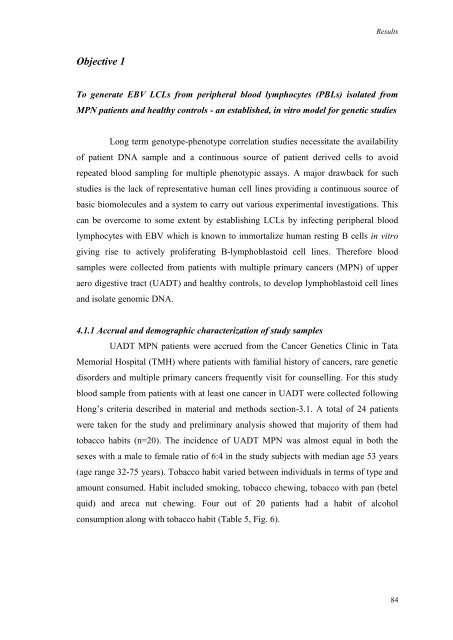LIFE09200604007 Tabish - Homi Bhabha National Institute
LIFE09200604007 Tabish - Homi Bhabha National Institute
LIFE09200604007 Tabish - Homi Bhabha National Institute
You also want an ePaper? Increase the reach of your titles
YUMPU automatically turns print PDFs into web optimized ePapers that Google loves.
Results<br />
Objective 1<br />
To generate EBV LCLs from peripheral blood lymphocytes (PBLs) isolated from<br />
MPN patients and healthy controls - an established, in vitro model for genetic studies<br />
Long term genotype-phenotype correlation studies necessitate the availability<br />
of patient DNA sample and a continuous source of patient derived cells to avoid<br />
repeated blood sampling for multiple phenotypic assays. A major drawback for such<br />
studies is the lack of representative human cell lines providing a continuous source of<br />
basic biomolecules and a system to carry out various experimental investigations. This<br />
can be overcome to some extent by establishing LCLs by infecting peripheral blood<br />
lymphocytes with EBV which is known to immortalize human resting B cells in vitro<br />
giving rise to actively proliferating B-lymphoblastoid cell lines. Therefore blood<br />
samples were collected from patients with multiple primary cancers (MPN) of upper<br />
aero digestive tract (UADT) and healthy controls, to develop lymphoblastoid cell lines<br />
and isolate genomic DNA.<br />
4.1.1 Accrual and demographic characterization of study samples<br />
UADT MPN patients were accrued from the Cancer Genetics Clinic in Tata<br />
Memorial Hospital (TMH) where patients with familial history of cancers, rare genetic<br />
disorders and multiple primary cancers frequently visit for counselling. For this study<br />
blood sample from patients with at least one cancer in UADT were collected following<br />
Hong‟s criteria described in material and methods section-3.1. A total of 24 patients<br />
were taken for the study and preliminary analysis showed that majority of them had<br />
tobacco habits (n=20). The incidence of UADT MPN was almost equal in both the<br />
sexes with a male to female ratio of 6:4 in the study subjects with median age 53 years<br />
(age range 32-75 years). Tobacco habit varied between individuals in terms of type and<br />
amount consumed. Habit included smoking, tobacco chewing, tobacco with pan (betel<br />
quid) and areca nut chewing. Four out of 20 patients had a habit of alcohol<br />
consumption along with tobacco habit (Table 5, Fig. 6).<br />
84

















